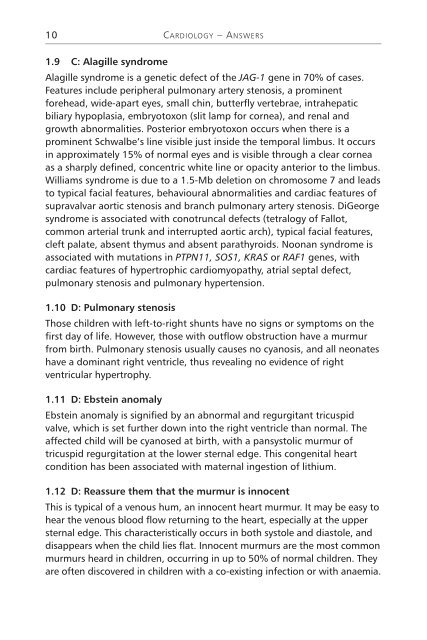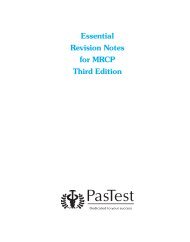MRCPCH 1: Essential Questions in Paediatrics - PasTest
MRCPCH 1: Essential Questions in Paediatrics - PasTest
MRCPCH 1: Essential Questions in Paediatrics - PasTest
- No tags were found...
Create successful ePaper yourself
Turn your PDF publications into a flip-book with our unique Google optimized e-Paper software.
10CARDIOLOGY – ANSWERS1.9 C: Alagille syndromeAlagille syndrome is a genetic defect of the JAG-1 gene <strong>in</strong> 70% of cases.Features <strong>in</strong>clude peripheral pulmonary artery stenosis, a prom<strong>in</strong>entforehead, wide-apart eyes, small ch<strong>in</strong>, butterfly vertebrae, <strong>in</strong>trahepaticbiliary hypoplasia, embryotoxon (slit lamp for cornea), and renal andgrowth abnormalities. Posterior embryotoxon occurs when there is aprom<strong>in</strong>ent Schwalbe’s l<strong>in</strong>e visible just <strong>in</strong>side the temporal limbus. It occurs<strong>in</strong> approximately 15% of normal eyes and is visible through a clear corneaas a sharply def<strong>in</strong>ed, concentric white l<strong>in</strong>e or opacity anterior to the limbus.Williams syndrome is due to a 1.5-Mb deletion on chromosome 7 and leadsto typical facial features, behavioural abnormalities and cardiac features ofsupravalvar aortic stenosis and branch pulmonary artery stenosis. DiGeorgesyndrome is associated with conotruncal defects (tetralogy of Fallot,common arterial trunk and <strong>in</strong>terrupted aortic arch), typical facial features,cleft palate, absent thymus and absent parathyroids. Noonan syndrome isassociated with mutations <strong>in</strong> PTPN11, SOS1, KRAS or RAF1 genes, withcardiac features of hypertrophic cardiomyopathy, atrial septal defect,pulmonary stenosis and pulmonary hypertension.1.10 D: Pulmonary stenosisThose children with left-to-right shunts have no signs or symptoms on thefirst day of life. However, those with outflow obstruction have a murmurfrom birth. Pulmonary stenosis usually causes no cyanosis, and all neonateshave a dom<strong>in</strong>ant right ventricle, thus reveal<strong>in</strong>g no evidence of rightventricular hypertrophy.1.11 D: Ebste<strong>in</strong> anomalyEbste<strong>in</strong> anomaly is signified by an abnormal and regurgitant tricuspidvalve, which is set further down <strong>in</strong>to the right ventricle than normal. Theaffected child will be cyanosed at birth, with a pansystolic murmur oftricuspid regurgitation at the lower sternal edge. This congenital heartcondition has been associated with maternal <strong>in</strong>gestion of lithium.1.12 D: Reassure them that the murmur is <strong>in</strong>nocentThis is typical of a venous hum, an <strong>in</strong>nocent heart murmur. It may be easy tohear the venous blood flow return<strong>in</strong>g to the heart, especially at the uppersternal edge. This characteristically occurs <strong>in</strong> both systole and diastole, anddisappears when the child lies flat. Innocent murmurs are the most commonmurmurs heard <strong>in</strong> children, occurr<strong>in</strong>g <strong>in</strong> up to 50% of normal children. Theyare often discovered <strong>in</strong> children with a co-exist<strong>in</strong>g <strong>in</strong>fection or with anaemia.
















